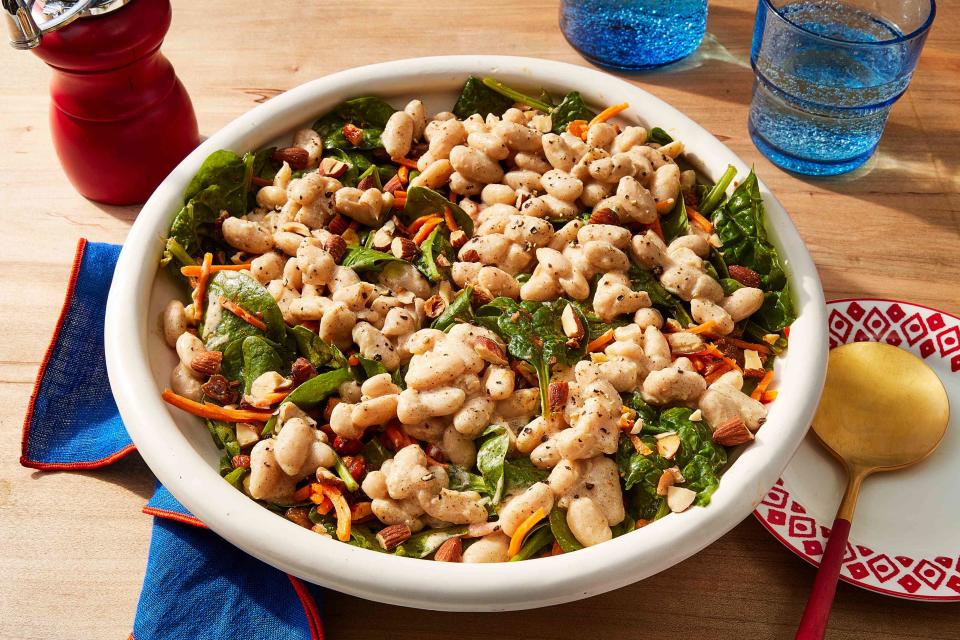I'm a Dietitian & These Are the Reasons Why I Love Canned Beans
Plus, tips on how to use canned beans in recipes.

Jen Causey
Welcome to Thrifty. A weekly column where nutrition editor and registered dietitian Jessica Ball keeps it real on how to grocery shop on a budget, make healthy meals for one or two, and make Earth-friendly choices without overhauling your entire life.
As a dietitian on a budget, I’m always looking for ways to help my dollar go further at the grocery store. For this reason, I started adding more canned beans to my cart a few years ago. And ever since, I’ve discovered several reasons to love them. In fact, nowadays, running out of canned beans is my trigger to go to the grocery store and stock back up, so I always have a constant supply. Canned beans are a very nutritious, inexpensive and incredibly versatile food. Read on for more details on why I love them so much, plus some of my favorite ways to use them.
They’re Super Nutritious
Foods made from scratch are often thought of as healthier than prepared foods. But is this the case with dried beans compared to canned beans? You may be surprised to know that the nutrition is nearly identical when comparing canned beans to beans cooked from dried. According to the Department of Agriculture, the nutrition for 1 cup of low-sodium canned black beans and 1 cup of cooked black beans from dried is as follows:
Nutrition | ||
Calories | 218 | 227 |
Carbohydrates | 40g | 41g |
Dietary Fiber | 17g | 15g |
Total Sugar | 0.5g | 0.5g |
Added Sugar | 0g | 0g |
Protein | 14.5g | 15g |
Total Fat | 0.7g | 0.9g |
Saturated Fat | 0.1g | 0.2g |
Cholesterol | 0mg | 0g |
Sodium | 331mg | 2mg |
Potassium | 739mg (28% Daily Value) | 611mg (24% DV) |
Iron | 4.6mg (26% DV) | 3.6mg (21% DV) |
Magnesium | 84mg (26% DV) | 120mg (37% DV) |
As you can see, canned and dried prepared beans are pretty much the same in calories, protein, fat and carbohydrates. The main difference between the two is that canned beans can sometimes have more sodium added during processing, whereas you can control the amount of salt added to beans you cook at home. If you’re looking to limit sodium in your diet, opt for “low-sodium” or “no-salt-added” canned beans. Additionally, remember to rinse any canned beans, as the liquids they’re stored in are where most of the sodium content resides.
Regardless of how they’re prepared, beans are a great source of protein, fiber, vitamins and minerals like potassium, iron and magnesium. Simply put, they’re a great addition to your diet. In fact, some experts consider them the #1 food to help you live longer and healthier.
Related: What Happens to Your Body When You Eat Beans Every Day
They’re Versatile and Convenient
Not only are canned beans packed with nutrition, but they’re also really convenient—especially compared to their dried counterparts. Dried beans can take hours of simmering before they’re ready to add to a dish, whereas canned beans can be used as soon as you open the can. Plus, canned beans can last for years in your pantry as long as the can isn’t dented or damaged in any way. So you can easily keep them on hand without worrying about them going bad.
Even more so, canned beans come in a variety of shapes, sizes and flavors, making them a great addition to numerous dishes. Try them in a salad or grain bowl like our Fiber-Packed White Bean & Spinach Salad or Grilled Vegetable and Black Bean Farro Bowls for some added protein and fiber. Or let them be the star of the show in dishes like Mashed Chickpea Salad with Dill & Capers or Baked Bean Casserole. Blend them up into a luscious, creamy dip like our Garlic Hummus when you need an appetizer in a pinch. You can even add them to sweet recipes like our Peanut Butter & Chickpea Blondies.
They’re Budget-Friendly
Last but certainly not least, beans are one of the most cost-effective foods to help you eat healthier. They typically cost around $1 per can, only about $0.06 per ounce, whereas meats or meat alternatives can cost around $0.50 per ounce (for less expensive cuts like ground beef or chicken thighs). That means choosing meat may cost you 10 times as much as canned beans! And meat has a much shorter shelf life, so it’s more likely to lead to food waste than a trusty can. So, as you can see, canned beans are s a budget-friendly way to add more satisfying protein to your meal.
Planning at least one bean-focused meal each week helps me eat more plant-based, save money and meet my nutritional goals while aligning with my budget. Hot tip: I like to stock up on beans at Costco to save even more and to make sure I’ll always have some when needed.
The Bottom Line
If you’re looking to save money and eat healthy, canned beans are one of the best protein sources around. Plus, they last for years and are ready to use for quick and easy meals. They might even help you meet your nutrition goals and promote longevity, too! I hope these reasons motivate you to add more beans to your meals and grocery list. For even more inspiration, check out this collection of my favorite budget-friendly recipes starring canned beans.
Read the original article on Eating Well.

